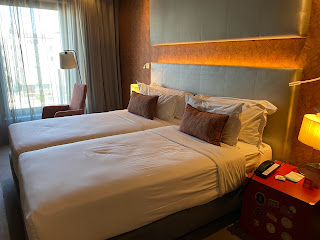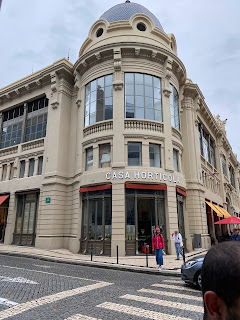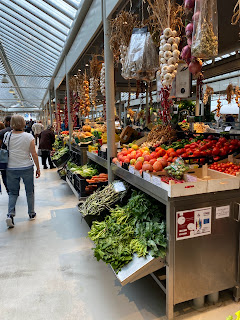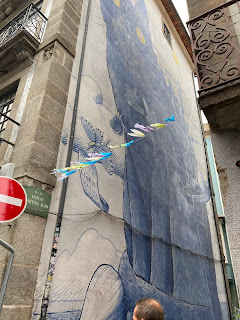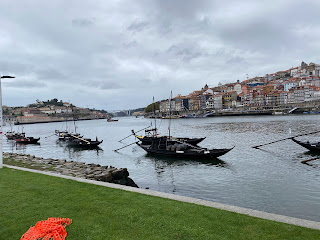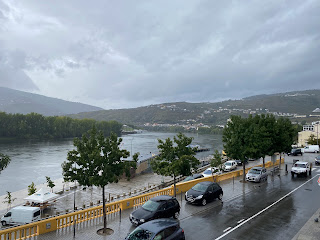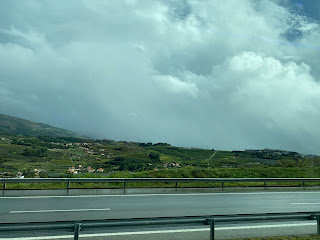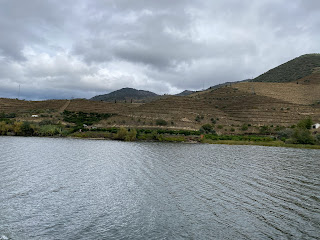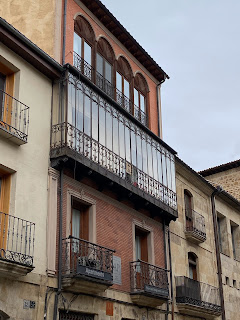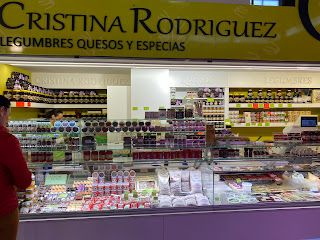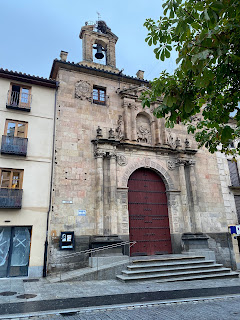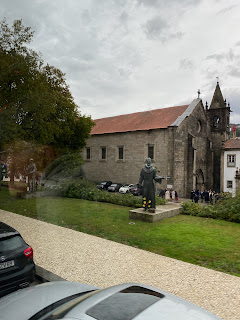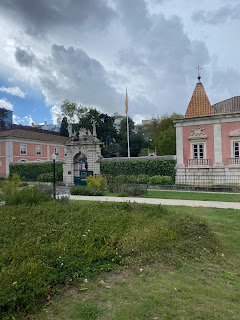Portugal Trip
13 - 25 October 2024
I booked a riverboat tour in Portugal with Uniworld aboard the Sao Gabriel. I flew American Airlines from DFW to Philadelphia to Lisbon leaving on Friday and arriving on Saturday. Traveling with only a backpack and a carryon bag made flying much simpler. After passing through Passport Control in Lisbon, I walked downhill about 200 meters from the terminal in bright sunshine to Hotel Melia Lisboa. Checking in was easy because I had paid for 2 nights so that I could go to the room when I arrived. The room was clean and adequate—nothing special. I think everything in it came from Ikea.
Before dinner, the Hotel Director welcomed us, gave the safety lecture, and introduced the cruise manager. After a brief overview, she explained tonight’s and tomorrow’s activities. The following day’s schedule was explained each day before dinner. The sun had begun to peek through as we enjoyed a one hour's scenic sail before tying up again before dinner.
Tuesday 17 October -. It was raining. We sailed through the deepest lock in Europe around 8:30. After leaving the lock, I was fascinated by the houses and buildings perched on the steep riverbanks. The sun began to peek through about 9:30. Shortly after that, we sailed beneath a long viaduct. Terraced hillsides contained vineyards on the eastern side of the river while craggy granite lined the opposite side.
Around 10:30 we tied up at a commercial pier in Caidas de Aregos for supplies. About 11, we boarded a bus and a ten minute drive across the river to the Duoro Museum in Regua, a town of 17,000. it was 20 C (68F). On the drive we learned that there are 25 riverboats operating on the Duoro and that locks must be booked 3 years in advance. At the museum, we heard a lecture and saw a video about wine making in the Duoro Valley, the oldest regulated wine region in the world. A mountain range blocks the strong winds from the coast and a climate of 9 months of winter and 3 months of hell is perfect for growing naturally sweet grape. Temperatures can reach 25 to 27 degrees C (77 to 80F) during the summer. Vineyards are created by breaking through the granite shale to reach soil and construct terraces; this was originally accomplished by backbreaking manual labor. Older terraces hold one row of vines while some newer ones created by machinery have two or three. Most rows are horizontal on terraces but if the slope is less than 35 degrees, the rows may be vertical. All vines are varietals grafted onto American root stock. Many vineyards are bordered by olive trees which help hold the soil, and all contain rose bushes to alert to the presence of a fungus which is killed by spraying. The terrain requires that almost all harvesting is done by hand. Originally women picked the grapes and men carried the filled baskets from the vineyards. Women were required to sing while picking to prove they weren’t eating the grapes. An interesting video from the 1960s showed the Duoro River before dams were built on it. Often the boats hauling the wine had to be pulled by men using ropes or by oxen.
We returned to the boat shortly after noon for a buffet lunch. At 2, we boarded buses and drove a little more than 30 minutes to Lamego, a town of 23,000. It was raining and 19C (66F). We didn’t see many vineyards because they don’t grow grapes higher than 500 meters; we saw olive trees. Several gas stations showed €1.85/liter (about $5.18/gallon). Our destination was the Sanctuario de Nossa Senhora dos Remedios, a hilltop church situated at the top of an elaborate staircase of 684 steps which some penitents climb on their knees. Not on your life! The bus dropped us off just behind the church, and we went inside for a tour.
While some walked down the 684 steps to the town; I rode the bus. We learned that during WWII, the French brought white grapes to the region and taught the Portuguese how to make champagne, which must be called sparkling wine. Crowning another hilltop is Castelo de Lamego, a medieval structure. During the Inquisition, it served first as a refuge for Jews; later it became a ghetto for those who did not convert.
Once in town, we received a tour of the cathedral during which we learned how to differentiate between gold leaf and gold paint.
Wednesday 18 October - We sailed east and there was intermittent sunshine.. At 8:20, we arrived at a lock; passage took about 30 minutes. After passing through the lock, the scenery included vineyards and olive groves. As the terrain changed, some vineyards became larger. At 11, Catarina presented an enjoyable Portuguese lesson. It’s similar enough to Spanish to be both easy and confusing. We were scheduled to pass through a lock at 2 and leave on a tour at 2:30. That didn’t happen because we had to wait for a downstream boat to clear the lock. Our schedule was off by 30 minutes.
The town where we disembarked is the last town on the Duoro Railway which begins in Porto. We boarded buses for Castelo Rodrigo, a medieval village. The one-hour scenic drive coiled its way through a countryside of vineyards, olive groves, and almond orchards. We learned that green and black olives are the same depending on when they’re picked; green ones are picked in September and black ones in January. We drove through the Coa River Valley, intended site of a dam and reservoir. The discovery of Paleolithic carvings prevented the construction. School children and young people led the opposition with the slogan, “Carvings Can’t Swim.” We saw a couple of flocks of sheep. Upon seeing some cork oak trees, we learned about harvesting cork and its many uses; some trees had numbers on them showing when the cork was harvested because 10 years should elapse before the cork can be harvested again. The hilltop ruins of Castelo Rodrigo stood out against the partly sunny sky. A very strong wind made being outside uncomfortable and walking the uneven stone streets was treacherous. Miriam explained the history of the village to us before we visited the church. Afterwards we visited the pillory to learn of medieval punishment. I skipped the downhill walk to the Jewish quarter and visited a couple of shops selling cork items, almonds, and snacks before boarding the bus which was parked beside the cemetery.
We had a 45-minute drive to the riverboat tied up at Barca D’Alva on the Spanish border. One small herd of cattle grazed near a barn. At one point on the drive we were able to see both Portugal and Spain on opposite sides of a tributary to the Duoro River. The night’s entertainment was the opening of a bottle of vintage port.
Thursday 19 October - Departure for Salamanca was set for 8:30. The forecast showed rain and a high of 59F. At 10:37, the bus departed Barco D’Alva and we quickly crossed the River Agatha and entered Spain. It was overcast, rainy, and 16C (61F). Although Spain is one hour ahead of Portugal time wise, we operated on Portuguese time all day. We followed a twisting route up through hills to reach a plateau. While Portugal has a population of 10 million with another 4 million citizens living overseas, Spain has a population of over 40 million. Town, each dominated by a large church, seemed to cower under gloomy skies in temperatures of 15C (59F). The highway across the undulating terrain was punctuated by speed bumps in towns or at intersections. The landscape reminded me of west Texas; there was prickly pear. There was plenty of stone to provide material for buildings, fences, and have some leftover. Oak trees produce the acorns to feed Black Iberian Pigs, source of the famous jamon. Miriam mentioned dairies, but I only saw beef cattle. Rain fell much harder, and the temperature dropped to 12C (54F). In fact, the nearer we got to Salamanca, the harder it rained. There’s some truth in the song lyrics “The rain in Spain stays mainly in the plain.”
When we reached Salamanca at 10:35, it was raining and 14C (57F). The rain tapered off as we walked to the Hotel Palacio San Esteban for pastries, sandwiches, coffee, and restrooms.
At 11:15 we enjoyed almost 15 minutes of sunshine as we walked to the Plaza Mayor for some free time. Because of the siesta, many shops close at 2 for a couple of hours, so shopping time was before lunch.
Old Faded Student Writing
Original Classroom
Modern Student Writing
Old Chapel Ceiling
"New Chapel"
Newer Chapel
Altar
Tombs Beneath Floor
Choir
All Saints Chapel
Exiting the cathedral about 2pm, I walked down the street and found a tapas bar for lunch. We met at the Cathedral at 3:30 for the rainy walk to the bus. The weather was miserable with rain the entire time. The bus left at 3:40 for the return to the riverboat over the same route as the morning. There was no rain for the first hour of the drive, and rain fell intermittently after that. Go figure! The landscape appeared to be drenched with water standing in every low spot. Some sun broke through the black clouds about the last 20 minutes of the drive.
Friday 20 October - We began our journey downriver to Porto Antigo. Scenic cruising filled the morning as the sun shone brightly. There was an afternoon tour to Quinto do Seixo, home of Sandeman wines, but I chose not to go.
Saturday 21 October – At first light, the boat sailed from Porto Antigo towards Porto. We sailed into Porto under partly cloudy skies. Street markets along the riverbank were crowded. We tied up at Cais de Gaia.
After lunch, I got ready for the tour to Guimaraes, known as the birthplace of Portugal; It was 23C (74F) when the bus left Gaia for the 50 minute drive to Guimaraes. A narrow roadway wound uphill, but we soon reached a motorway. We learned that this region grows corn, and that grapevines surround the fields and serve as boundary lines. The area is known for its Portuguese Stew made with pork and vegetables and often served with rice. Chestnut trees grow here and are a staple of many peoples’ diets. Eucalyptus trees were imported to drain marshlands and are now cultivated for paper production. The Moors were defeated in 858, and Henry of Burgundy ruled the area. A monastery was established at Guimaraes on the pilgrimage path to Santiago de Compostelo. Henry and his wife Teresa had a son Alfonso, who had a deformed leg. Henry died when Alfonso was a minor and Teresa ruled as Queen. Alfonso rebelled at 16, defeated his mother, and became King. The Portuguese nobility helped him because Teresa was closely tied to Gallacia and Leon in Spain. Alfonso succeeded in expelling the Moors from Portugal and lived to the ripe old age of 76. We arrived at 3:50; it was 16C (61F). The bus dropped us at the top of a hill and we walked down. We saw some shells etched into the sidewalk indicating we were on the Pilgrimage Path. Reaching Sao Maria Street, we looked into shop windows and learned about torte chila, a sweet pastry filled with spaghetti squash. After passing the reconstructed castle, we reached the Church of Nossa Senhora de Olivera. An olive tree brought from the Holy Land by a pilgrim once stood here but was killed by people taking pieces from it for good luck. The present tree was planted in the 1980s and is protected. During free time, I bought a torte chila, probably the sweetest thing I ever tried to eat, and a hot chocolate. As we returned to the bus, we saw the cable car line on the mountain side and got a good view of the Church of Sao Gualter
We left at 4:55 for the return drive. Greenhouses, corn fields, hay, manufacturing plants, apartment buildings, and solar panels filled much of the landscape. Pampas grass grew at roadside. We had a nice view of the mouth of the Duoro as we crossed the bridge on our return.
Sunday 22 October – I went to breakfast at 7. It was bags out at 7:30; vacate cabin at 8:30; departure at 9:00. After claiming my bag and seeing it put aboard, I boarded Bus #1 for the trip to Lisbon. We left Gaia and made our way out of the city and onto the motorway. There were cornfields and eucalyptus trees growing beside the highway. After skirting Coimbra, site of The University of Portugal, we made a rest stop from 10:30 to 10:55 at a service plaza. Some of the huge towers supporting the power lines are festooned with massive stork nests; life for the storks is good here, so they no longer migrate. The terrain changed and we saw large vineyards as well as fruit trees: pear; apple; peach; cherry. We reached Obidos at noon and had free time until 1:40pm. I wandered through some shops and ate lunch.
A number of wind turbines dotted the landscape as we drove toward the capital city A few minutes before 3, the bus stopped in front of the Tivoli Hotel and we met Pilar. Inside the hotel, Pilar handed out schedules and gave us an overview of activities until our Wednesday departure. Someone from the hotel handed out room keys, and I was inside room 217 before 4. The welcome message on the TV was in German; I have been told Bonner is a German name.
I got ready for the Orientation Walk of the hotel area at 6:30. Pilar led us down the hill pointing out ATMs, restaurants, pharmacies, etc. By the time I walked back up the hill and got back to the hotel; it was almost 8.
Monday 23 October - At 8:30, we boarded a bus for a city tour with Isabel as our guide. We learned that Lisbon was founded by the Phoenicians and is the second oldest capital city in Europe after Athens. About 30% of the country’s population lives in greater Lisbon. We drove through Restoration Square as we made our way down towards the Tagus River. The city was almost completely destroyed in an earthquake and subsequent tsunami and fire on November 1, 1755; that day was a Sunday and many were at mass and holding candles. When rebuilding, a more regular pattern was established with parallel streets running uphill from the river. Lisbon is a city of cars, and parking and pollution are problems, so much so that EVs only pay €12 annually to park anywhere. Reaching the western part is the city, we got off the bus near the Belem Tower which was constructed in the 16th century for defense and as the location for embarkation and disembarkation. The bridge crossing the river is reminiscent of The Golden Gate Bridge and was constructed by the same company.
. Near here is the Jeronimos Monastery, burial place of Vasco de Gama.
We saw many tile-covered walls on both buildings and along roadways.
We arrived at the hotel a few minutes before noon. The President of Guinea was visiting Portugal and staying in our hotel. There was no shortage of Security and Police in and around the hotel.
Wednesday 25 October - Breakfast opened at 6:30am. My bag was to be collected from the room at 7am and departure for the airport at 7:30am. Our group boarded the minibus and left for the airport at 7:25. The flight to Philadelphia departed on time, and we landed in Philadelphia on time. I breezed through e Immigration and Customs and checked the board for AA451 to DFW. The flight was delayed from 4:13 to 5:54 because of storms in DFW. We actually took off at 5:51, and the flight was smooth until about the last hour when storms around the airport made for a very bumpy flight. For the last 45 minutes everyone, including the flight attendants, had to stay seated. We aborted 2 landing attempts before landing at 8:59. Some passengers clapped at touchdown, and the flight attendant came on the PA and asked, “How’re y’all doing back there?” Then she said, “That was rough, even for me.” I came home through some of the heaviest rain I’ve ever seen.


